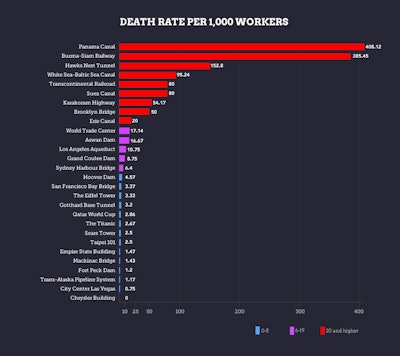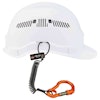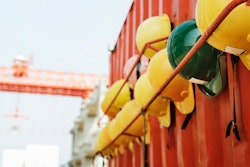
Not a day goes by in the construction industry where safety isn't a topic of discussion. News stories of construction collapses happen all too frequently. In fact, just a few days ago one construction worker was killed and two others seriously injured at the site of a new residential building in The Bronx that collapsed during construction.
Construction is a dangerous industry, but that doesn't mean we should just accept that fatalities will happen. All construction workers and construction business owners have the power and the responsibility to make sure every laborer has what they need to perform their jobs safely and get home safely every night.
Read next: Is It Really Worth the Cost to Keep Construction Workers Safe?And that safety needs to spread to the public, too. On historical construction projects, the fatalities were usually the laborers. In today's environment — where construction is being done in more populated cities and the trend is to build up — the public is put at risk, too. Construction accidents have caused the deaths of bystanders, drivers and even those in their own homes.
For example, in 2015, a crane collapsed at Saudi Arabia's Grand Mosque killing 107 people. A report from the time of the accident claims strong winds and heavy rains caused the collapse — a common claim for crane collapses — and proving that it's not just during the work day safety that the construction industry must be concerned with.
Famous construction projects prove deadly
In 2015, Safer America published an interactive timeline taking a look at the modern era's most deadliest construction projects. The research takes a look at both the total number of construction worker deaths during the construction projects as well as where the projects rank in highest death rate per 1,000 construction workers.
Interesting to note is the seven skyscraper building projects included totaled the least amount of construction worker deaths at just 82. Bridges, which included five projects, followed closely with only 90 worker deaths (although even 90 is still far too many).
Canal projects had the highest total of construction worker deaths with 163,609 deaths in only four projects. Railway projects also had a large number with 107,200 spread across only two railroad projects. Tunnel and dam projects recorded a total of 772 and 733 construction worker deaths respectively.
Read next: Construction Safety Week Should Be a Year-long Celebration
Five other projects including the Titanic, the Trans-Alaska Pipeline, Los Angeles Aqueduct, Karakoram Highway and the Qatar World Cup have totaled 5,383 construction worker deaths, with 4,000 of those worker fatalities on the Qatar project.
Unfortunately, big event construction projects like the Qatar World Cup and Olypmic venues still tend to result in multiple deaths. Construction for the 2016 Rio de Janeiro Olympics saw at least 11 worker deaths. The total death toll for construction for the 2014 Sochi Olympics remains unknown. Reports vary from double to triple digit fatalities.
Canal construction was dangerous
Taking a look at the death rate per 1,000 workers, the Panama Canal is by far the deadliest construction project with 408.12 construction worker deaths per 1,000 workers — a total of 30,609 deaths. On the opposite end of the spectrum, the Chrysler Building had zero construction worker deaths.
The other three canal projects that made Safer America's list included the Erie Canal, which recorded 1,000 deaths from its 50,000 workers. The Erie Canal deaths are attributed to disease from swampy terrain, careless use of gunpowder while blasting, drowning and frequent canal collapses which buried workers under tons of rubble.
The Suez Canal had 120,000 deaths among its 1.5 million workers during the 11 year excavation project — the most construction worker deaths of the four canal projects. The White Sea-Baltic Sea Canal project took the lives of 12,000 of its construction labor workforce, which was made up entirely of inmates. Unofficial estimates have the death toll running as high as 25,000 workers who died due to starvation, cold and physical exhaustion.
Like the Chrysler Building, which had 3,000 workers and zero deaths, the Eiffel Tower kept its construction worker death toll down to one worker with much credit going to extensive use of guard rails and safety screens. The other U.S. skyscraper projects included the Empire State Building, which had five deaths among its 3,400 workers during construction; the 1970s World Trade Center construction which recorded 60 construction worker deaths; the Sears Tower which recorded five worker deaths in two incidents; and Las Vegas's CityCenter project which resulted in the deaths of six construction workers.
The only other foreign skyscraper on the list, the Taipei building, also recorded five construction worker deaths after a 6.8 magnitude earthquake caused cranes to collapse.
Tunnels and railroads weren't much better
Hawks Nest Tunnel is a three-mile-long tunnel through Gauley Mountain in West Virginia constructed in 1931. The project is known as one of the worst industrial disasters in U.S. history, and while the Safer America research says the project caused the death of 764 construction workers and had the third highest death rate per 1,000 workers at 152.8, the exact number of fatalities is hard to pinpoint. Many workers died from an incurable lung disease known as silicosis, which can take a few years to become fatal.
Research estimates that at least 764 workers who worked underground for only two months died within five years of the tunnel's completing. Other estimates figure the death toll to be over 2,000.
The Gotthrad Base Tunnel suffered much less loss with eight construction worker deaths, although the world's longest and deepest traffic tunnel was still under construction at the time of the Safer America report.
While canal projects did have the highest death totals, railway projects were probably the most dangerous recording over 100,000 deaths on just two projects — The Transcontinental Railroad with 1,200 deaths, although this number has never been verified, and the Burma-Siam Railway with 106,000 construction worker deaths. The Burma-Siam Railway was also known as the "Death Railway".
Not on the Safer America list is the New York City Third Water Tunnel. This tunnel started construction in 1970 and was expected to be completed in 2020. Between 1970 and 1997, 24 people died in construction related accidents. Twenty-three of these were construction workers while the other one was a boy who was exploring uncapped water pipes in the Bronx.
Dam and bridge construction fared better
Of the four dam projects that made the list, the Aswan Dam was the only one that recorded more than 100 deaths with 500 construction worker fatalities. The Hoover Dam recorded the next highest number with 96 followed by the Grand Coulee Dam at 77 and the Fort Peck Dam at 60.
Surprisingly, bridge construction projects have been relatively safe over the course of history. The Brooklyn Bridge recorded 30 construction worker deaths, the highest total of all the bridge projects featured. The Sydney Harbour Bridge in Australia recorded 16 deaths, with only two of those resulting from falls off the bridge.
The San Francisco Bay Bridge and the Golden Gate Bridge recorded 28 and 11 construction worker deaths, respectively. The San Francisco Bay Bridge fatalities helped spur the creation of safety nets for use on similar projects in the future. The Golden Gate Bridge was completed just months after the Bay Bridge. Of the 11 fatalities, 10 happened in a single incident when a 5-ton work platform broke. Chief Engineer Joseph Strauss made safety a top concern and spent $130,000 on safety nets. The Golden Gate Bridge was also the first construction site in America that required construction workers to wear hardhats.
Finally, the Mackinac Bridge recorded five deaths.
Left off the Safer America list, the Willow Island disaster of 1978 caused the deaths of 51 workers. The project was construction of a cooling tower in West Virginia. On April 27, 1978, the third lift of concrete was being raised for the cooling tower. The cable hoisting the bucket of concrete went slack, the crane lifting it fell toward the inside of the tower, and concrete began to collapse from the top of the tower. The falling concrete caused the scaffolding holding 51 construction workers to collapse, killing all 51 construction workers.
What can the construction industry learn from these historical and modern construction projects in regards to safety on the jobsite?
This article was originally published in 2015 and has been updated to reflect the 2019 construction environment.




















